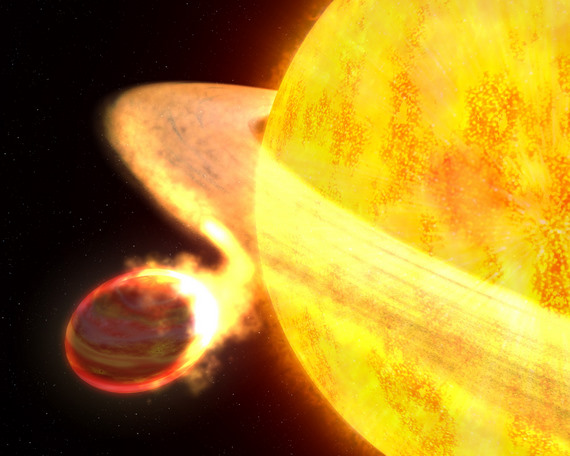The planet WASP-12b is so close to its sun that it completes its orbit in 1.1 days, and it heats up to a temperature of nearly 1,540 degrees Celsius. This planet is stretched like an American football due to the enormous tidal forces. The atmosphere has swelled to 3 times the diameter of Jupiter, and it is spitting material into the star

In February of this year (2010), it was first reported that WASP-12b, the hottest planet in the Milky Way, was torn apart by its own sun. Shu-Lin Li of the Department of Astronomy at Peking University in Beijing predicted that the star's gravity would distort the planet's surface and make the planet's interior so hot that the atmosphere would escape and merge with the parent star. According to his calculations, the planet will be completely consumed by its sun. Recently, the Hubble Space Telescope confirmed the prediction, and astronomers estimate that the planet will live another 10 million years before completely disappearing inside the Sun.
Astronomers using the Cosmic Source Spectrograph (COS) and the Hubble Space Telescope's sensitive ultraviolet instrument saw that the planet and its sun share elements and pass them back and forth between them. "We observed a huge cloud of matter surrounding the planet, escaping from the planet and one day being captured by the star. We have identified chemical substances that we have never seen on a planet outside the solar system, says the head of the group, Carol Hewell of the UK's Open University.
This result of material transfer between two stellar objects is usually common in binary star systems where the stars are very close together, but this is the first time it has been clearly observed when a planet is involved in the process.
The planet, known as WASP-12b, is so close to its Sun-like star that it completes its orbit in 1.1 days, and is heated to a temperature of nearly 1,540 degrees Celsius. It is also stretched like an American football due to the enormous tidal forces. The atmosphere has swelled to 3 times the diameter of Jupiter, and it is spitting material into the star. The planet is about 40% more massive than Jupiter.
The star itself, WASP-12 is a yellow dwarf located about 600 light-years from us in the direction of the winter Origa group.
Haswell and her team published the paper in the May 10, 2010 issue of the Astrophysical Journal Letters.

14 תגובות
dwarf,
Your mistake is largely due to the fact that there is something very misleading in the name "yellow dwarf" since all the other dwarfs (white, black or brown) are not main sequence stars and suddenly precisely this type of main sequence stars was given such a name - indeed stupid.
By the way, the sun is not even that small and in fact most of the stars we see are smaller than it.
Well, I was talking nonsense, our sun is a yellow dwarf, and it's not complaining.
two questions:
1) What is meant by "similar to our sun" - after all, our sun still has a little time until its trying stages. Do you mean the total mass or the current diameter?
2) If a yellow dwarf means that the star is dying and contracting, does that mean that its diameter before was so much larger that it might even have contained the planet?
to the juices
Meowwww w w w w w...
do you feel better now?
lush:
As a cat - what do you think because Tlini?
Cats don't understand mathematical calculations and that's what it's all about.
It's so pathetic for humans who barely live a hundred years to talk about things that will happen in a million more years. Pathetic, simple and stupid.
Father, the temperature is not the only mistake in the translation in the article, please don't translate word by word but matter-of-factly
I understand, the planet will not merge with the star but will shed its mass towards the star.
The association Tano La Kochav Live will hold a demonstration in front of the Knesset tomorrow, everyone is invited
All that's left is to say - bon appetit!
Max Power:
It's nice to know that someone read the explanations I gave in the discussion under this article:
https://www.hayadan.org.il/the-planet-that-shouldnt-exist-0209097
However, this is not the subject of this article.
Here it is not about the planet spinning towards the star or away from it, but about the gradual elimination of the planet by the star
The speed of rotation of the star on its axis is not indicated in the article, if it rotates faster than the planet that orbits it, the planet will move away from it and not capture it.
Thanks, corrected.
You have a mistake in the degrees, it's 2800 Fahrenheit not Celsius
And also "torn to pieces" and not read